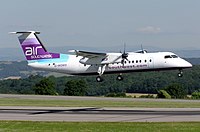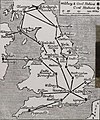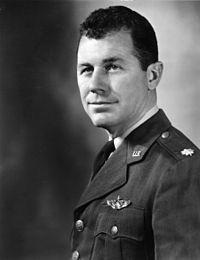Portal:Aviation
| Main page | Categories & Main topics |
|
Tasks and Projects |
The Aviation Portal

Aviation includes the activities surrounding mechanical flight and the aircraft industry. Aircraft includes fixed-wing and rotary-wing types, morphable wings, wing-less lifting bodies, as well as lighter-than-air aircraft such as hot air balloons and airships.
Aviation began in the 18th century with the development of the hot air balloon, an apparatus capable of atmospheric displacement through buoyancy. Clément Ader built the "Ader Éole" in France and made an uncontrolled, powered hop in 1890. This is the first powered aircraft, although it did not achieve controlled flight. Some of the most significant advancements in aviation technology came with the controlled gliding flying of Otto Lilienthal in 1896; then a large step in significance came with the construction of the first powered airplane by the Wright brothers in the early 1900s. Since that time, aviation has been technologically revolutionized by the introduction of the jet which permitted a major form of transport throughout the world. (Full article...)
Selected article
Selected image
Did you know
...that Luftwaffe ace Erich Rudorffer flew more than 1000 missions during World War II, and was shot down sixteen times by enemy flak and fighters? ...that the Alexander Aircraft Company, which produced Eaglerock biplanes in Colorado, was the largest aircraft manufacturer in the world for a brief period between 1928 and 1929? ... the Safety Promotion Center, established by Japan Airlines after the worst single aircraft accident in history, has passengers' farewell letters and wreckage on display to educate employees about safety?
General images -
In the news
- May 29: Austrian Airlines cancels Moscow-bound flight after Russia refuses a reroute outside Belarusian airspace
- August 8: Passenger flight crashes upon landing at Calicut airport in India
- June 4: Power firm helicopter strikes cables, crashes near Fairfield, California
- January 29: Former basketball player Kobe Bryant dies in helicopter crash, aged 41
- January 13: Iran admits downing Ukrainian jet, cites 'human error'
- January 10: Fire erupts in parking structure at Sola Airport, Norway
- October 27: US announces restrictions on flying to Cuba
- October 3: World War II era plane crashes in Connecticut, US, killing at least seven
- September 10: Nevada prop plane crash near Las Vegas leaves two dead, three injured
- August 6: French inventor Franky Zapata successfully crosses English Channel on jet-powered hoverboard
Related portals
Associated Wikimedia
The following Wikimedia Foundation sister projects provide more on this subject:
-
Commons
Free media repository -
Wikibooks
Free textbooks and manuals -
Wikidata
Free knowledge base -
Wikinews
Free-content news -
Wikiquote
Collection of quotations -
Wikisource
Free-content library -
Wikiversity
Free learning tools -
Wikivoyage
Free travel guide -
Wiktionary
Dictionary and thesaurus
Selected biography
His career began in World War II as a private in the U.S. Army Air Forces. After serving as an aircraft mechanic, in September 1942 he entered enlisted pilot training and upon graduation was promoted to the rank of Flight Officer (WW 2 U.S. Army Air Forces rank equivalent to Warrant Officer) and became a P-51 Mustang fighter pilot. After the war he became a test pilot of many kinds of aircraft and rocket planes. Yeager was the first man to break the sound barrier on October 14, 1947, flying the experimental Bell X-1 at Mach 1 at an altitude of 45,000 ft (13,700 m). Although Scott Crossfield was the first man to fly faster than Mach 2 in 1953, Yeager shortly thereafter exceeded Mach 2.4.[1] He later commanded fighter squadrons and wings in Germany and in Southeast Asia during the Vietnam War, and in recognition of the outstanding performance ratings of those units he then was promoted to Brigadier-General. Yeager's flying career spans more than sixty years and has taken him to every corner of the globe, even into the Soviet Union during the height of the Cold War.
Selected Aircraft

The de Havilland Canada DHC-8, popularly the Dash 8, is a series of twin-turboprop airliners designed by de Havilland Canada in the early 1980s. They are now made by Bombardier Aerospace which purchased DHC from Boeing in 1992. Since 1996 the aircraft have been known as the Q Series, for "quiet", due to installation of the Active Noise and Vibration Suppression (ANVS) system designed to reduce cabin noise and vibration levels to near those of jet airliners.
Notable features of the Dash 8 design are the large T-tail intended to keep the tail free of propwash during takeoff, a very high aspect ratio wing, the elongated engine nacelles also holding the rearward-folding landing gear, and the pointed nose profile. First flight was in 1983, and the plane entered service in 1984 with NorOntair. Piedmont Airlines (formerly Henson Airlines) was the US launch customer for the Dash 8 in 1984.
The Dash 8 design had better cruise performance than the earlier Dash 7, was less expensive to operate, and more notably, much less expensive to maintain. The Dash 8 had the lowest costs per passenger mile of any feederliner of the era. The only disadvantage compared to the earlier Dash 7 was somewhat higher noise levels, but only in comparison as the Dash 7 was notable in the industry for extremely low noise due to its four very large and slow-turning propellers.
- Length: 107 ft 9 in (32.84 m)
- Wingspan: 93 ft 3 in (32.84 m)
- Height: 27 ft 5 in (8.34 m)
- Powerplant: 2× Pratt & Whitney Canada PW150A turboprops, 5,071 shp (3,781 kW) each
- Cruise speed: 360 knots (414 mph, 667 km/h)
- Maiden Flight: June 20, 1983
Today in Aviation
- 2013 – The Government of Myanmar admits for the first time that Myanmar Air Force jets and attack helicopters conducted air strikes against rebel Kachin Independence Army forces in northern Myanmar on 30 December 2012, but claims that all of its other air operations in the area since late December 2012 have focused only on flying in supplies to Myanmar Army forces fighting Kachin rebels.[2]
- 2013 – The United States carries out two air-to-surface missile strikes by unmanned aerial vehicles in Pakistan. One hits a vehicle near Wana in South Waziristan, killing all six militants in it, including the Pakistani Taliban commanders Maulvi Nazir Wazir and Rapa Khan. The other strikes a car near Mir Ali in North Waziristan, killing two Uzbek militants and the Pakistani Taliban commander Faisal Khan.[3]
- 2010 – Danube Wings Flight 8230: In Slovakia, a package containing the explosive RDX was placed in the luggage of a passenger at Poprad-Tatry Airport by Serbian police as part of a training exercise. Due to an error, the package was not recovered and the luggage was loaded onto a Danube Wings flight to Dublin. The error was not realized until the plane had departed. The Garda Síochána were not informed until 5 January, causing a bomb alert in Dublin. The innocent passenger was arrested but later released when the Slovak Government admitted he was blameless.
- 2010 – Boeing 727-231F 9Q-CAA of Congolese airline Compagnie Africaine d'Aviation was substantially damaged when it departed the side of the runway at N'djili Airport, Kinshasa.[4] The aircraft was later reported as damaged beyond repair.[5]
- 2008 – Asian Spirit Flight 321, an NAMC YS-11 departing from Manila, piloted by Captain Alexandro Tiglao with First Officer Dominick Mendoza as co-pilot, overshot the runway at Masbate Airport at 7:30 a. m., due to heavy tailwinds with gusts reaching 14 knots while landing on runway 21. Although none of the 47 passengers were seriously injured, the accident destroyed the aircraft’s nozzle, the plane’s right propeller and its right and nose wheel, and caused the plane’s fuel tank to leak.
- 2006 – A Cessna 206 filled with skydivers crashed into a dam near Ipswich, southwest of Brisbane, Queensland, Australia.[6]
- 2004 – USA Spacecraft Stardust successfully flies past Comet Wild 2, collecting samples that are returned to Earth.
- 2004 – Several British Airways flights from London Heathrow Airport to Washington D. C. and Riyadh, Saudi Arabia are cancelled due to security fears.
- 2004 – An OH-58D Kiowa 90-0370 from 1–17 Cavalry Regiment (assigned to 1–82 Aviation Brigade) shot down near Fallujah, killing a pilot.
- 1999 – Death of Karl-Heinz Bringer, German rocket engineer.
- 1989 – First flight of the Tupolev Tu-204, a Russian twin-engined medium-range jet airliner capable of carrying 210 passenger, first Russian fly-by-wire airliner.
- 1975 – Death of Theodor "Theo" Osterkamp, German WWI and WWII fighter ace, one of only a few men to score victories in both World Wars.
- 1972 – Death of James Butler White, DFC, RNAS, British RNAS WWI flying ace.
- 1968 – Col. Henry Brown and Lt. Col. Joe B. Jordan became the first U.S. Air Force pilots to use an General Dynamics F-111A's emergency escape module when their aircraft, 65-5701, c/n A1-19, of the Air Force Flight Test Center crashes near Edwards AFB, California, due to a weapons gun bay fire.
- 1967 – The contracts for the development of the Boeing SST and its engines are awarded
- 1967 – Seven North Vietnamese Mikoyan-Gurevich MiG-21s are destroyed by F-4 Phantoms of the 8th Tactical Fighter Wing USAF in Operation Bolo
- 1967 – The National Supersonic Transport program, formed by President John F. Kennedy for the purpose of subsidizing the design of a Concorde-fighting supersonic airliner, awards a contract to Boeing for its 2707 SST design. Despite 115 orders from 25 different airlines, the program would lose its funding in 1971, forcing Boeing to lay off 60,000 workers.
- 1965 – Denis Healey, the UK's Secretary of Defence cancels the nation's fighter and military transport programs and orders the purchase of the US-built F-4 Phantom and C-130 Hercules in their place.
- 1964 – A USAF Douglas C-124C Globemaster II, 52-968, c/n 43877, of the 28th Air Transport Squadron, en route from Tachikawa Air Force Base near Tokyo, Japan, to Hickam Air Force Base, Honolulu, Hawaii with nine on board and 11 tons of cargo, disappears over the Pacific Ocean after making a fuel stop at Wake Island. Due at Hickam at 0539 hrs. EST, the Globemaster II is last heard from at 0159 hrs. EST. Fuel exhaustion would have been at 1000 hrs. EST and the aircraft is presumed down at sea. An automatic SOS signal is detected emanating from an aircraft-type radio with a constant carrier frequency of 4728 kilocycles, issuing an automatically keyed distress message, and a dozen aircraft of the Air Force, Navy and Coast Guard are sent to search from Hickam and from Guam, Midway, and Johnston Island. Poor weather and limited visibility hampers search efforts. The U.S. Navy's USS Lansing also participates in the search. The eight missing Air Force crew and one U.S. Navy man escorting a body back to the U. S. are officially declared dead on 21 January. This was the first C-124 accident since May 1962.
- 1963 – The Battle of Ap Bac in South Vietnam is the first time that Viet Cong forces stand and fight against a major South Vietnamese attack. At the outset, Viet Cong ground fire shoots down a United States Army UH-1 attack helicopter and four U. S. Army CH-21 transport helicopters as they arrive at their landing zone. South Vietnamese Air Force C-123 Provider transport planes drop about 300 South Vietnamese paratroopers later in the day.
- 1959 – Launch of Luna 1 (E-1 series), first known as First Cosmic Ship, then known as Mechta, first spacecraft to reach the vicinity of the Moon. First of the Luna program of Soviet automatic interplanetary stations.
- 1954 – A new coast to coast record in the US is set by Colonel Willard W. Milliken of the Air National Guard, flying a North American F86 Sabre jet and covering 2,530 miles (4,070 km) from Los Angeles to New York City in 4 hours 8 min. (time includes stop for fuel at Offutt AFB).
- 1953 – First flight of the Sud-Ouest Djinn, a French single-seat light prototype helicopter. The rotors were driven by compressed-air jets at the end of each blade.
- 1953 – The first of an order of about 430 US Sabre fighters, the RAF’s first supersonic jet, arrives at RAF Abington, England.
- 1950 – A North Star aircraft of No. 412 Sqron made the first Royal Canadian Air Force round-the-world flight in a flying time of 125.2 hours. The flight was carrying Hon. Lester Pearson to Commonwealth foreign ministers conference in Ceylon.
- 1945 – U. S. Army Air Forces Twentieth Air Force B-29s based at Calcutta, India, bomb Bangkok, Siam.
- 1945 – Japanese aircraft attack United States Army Air Forces B-29 Superfortress bases on Saipan for the last time.
- 1944 – (2-13) Allied aircraft systematically attack rail communications in central Italy in an unsuccessful attempt to prevent Germany from supplying and reinforcing its forces fighting in southern Italy.
- 1943 – McDonnell gets a contract to build the Navy's first jet fighter.
- 1942 – The United States Navy opens a blimp base at Lakehurst, New Jersey.
- 1941 – Italian Air Force contingent in Belgium (Corpo Aereo Italiano) mounts its last raid on the UK, when 4 Fiat BR20 bombers attempt to bomb Ipswich.
- 1933 – After modifications, HMS Courageous reenters service with the Royal Navy as the world’s first aircraft carrier equipped with hydraulically controlled arresting gear.
- 1930 – Leroy Grumman, Leon Swirbul, and William Schwender found the Grumman Aircraft Engineering Corporation at Baldwin on Long Island, New York.
- 1929 – Evelyn "Bobbi" Trout flew a Golden Eagle 12 hours and 11 min at the Metropolitan Airport in Los Angeles, setting a new non-refueling endurance record for women.
- 1929 – Wilfrid Reid "Wop" May left in an Avro Avian with another flying club member, Vic Horner, to deliver diphtheria vaccine to Fort Vermilion, Alberta, 1,600 kilometres (990 mi) north. His flight had become known across Canada as "the race against death".
- 1918 – The British government establishes an air ministry. Lord Rothermere is Secretary of State for Air. Major-General Sir Hugh Trenchard is Chief of the Air Staff.
- 1914 – Gustav Hamel took Miss Trehawke Davis aloft to experience a loop, and she thus became the first woman in the world to do so.
- 1903 – Birth of Pjotr Michailowitsch Stefanowski, Soviet WWII test pilot.
- 1899 – Birth of Christopher McEvoy, British WWI flying ace.
- 1898 – Birth of Franz Büchner, one of the most successful German fighter aces of WWI.
- 1896 – Birth of Sir Lawrence James Wackett KBE, DFC, AFC, Australian WWI pilot and aircraft designer, widely regarded as "father of the Australian aircraft industry".
- 1895 – Birth of Leslie Norman "Holly" Hollinghurst GBE, KCB, DFC, British WWI flying ace and WWII high ranking RAF officer.
- 1895 – Birth of Alfred Niederhoff, German WWI flying ace.
- 1895 – Birth of Gustav Leffers, German WWI flying ace.
- 1894 – Birth of Valentine St. Barbe Collins, British WWI flying ace.
- 1893 – Birth of Cyrus K. Bettis, American aviator winner of the 1924 Mitchell Trophy Race and the 1925 Mackay Trophy.
- 1891 – Birth of Didier Daurat, French pioneer of commercial aviation.
- 1886 – Birth of Thomas Gillies Rae, Scottish WWI flying ace.
- 1882 – Birth of Frederick Walker Baldwin, also known as Casey Baldwin, Canadian engineer, hydrofoil and aviation pioneer, first Canadian to pilot an heavier-than-air flying machine.
- 1880 – Birth of Louis Charles Breguet, French aircraft designer and builder, one of the early aviation pioneers.
References
- ^ Yeager, Chuck, and Janos, Leo. Yeager: An Autobiography. p. 252 (paperback). New York: Bantam Books, 1986. ISBN 0-553-25674-2.
- ^ Associated Press, "Burma Military Admits Airstrikes Against Kachin," 2 January 2013.
- ^ Hussain, Shaiq, and Haq Nawaz Khan, "U.S. Drone Kills Militant Commander," The Washington Post, January 4, 2012, Page A8.
- ^ "Accident description". Aviation Safety Network. Archived from the original on 6 January 2010. Retrieved 2 January 2010.
- ^ "02. January 2010 Compagnie Africaine d´Aviation Boeing 727–200 9Q-CAA Kinshasa-N´djili International Airport, DR Congo" (PDF). Jacdec. Retrieved 4 January 2010.
- ^ Liz Minchin. "Five killed in skydive plane tragedy". The Age, 3 January 2006. Retrieved 22 October 2012.
- Shortcuts to this page: Portal:Airplanes • P:AVIA






















































